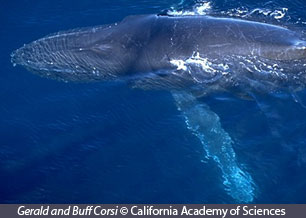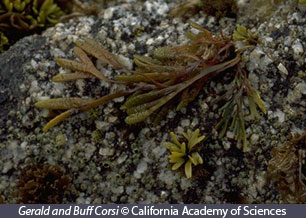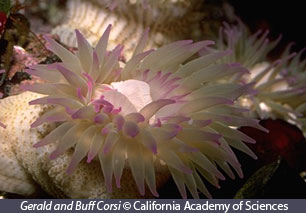Location | Weather | Plants | Animals | People | Links

LOCATION: The marine
biome is the biggest biome in the world! It covers about 70% of the earth. It
includes five main oceans: the Pacific, Atlantic, Indian, Arctic, and Southern, as well
as many smaller Gulfs and Bays. Marine regions are usually very salty! There is about one
cup of salt per gallon of water in the ocean.
The ocean is divided up into three vertical
zones. The top layer is called the euphotic zone and it is the area of the ocean where
light can penetrate. The next layer is the disphotic zone. This area is too deep for lots
of light to reach. Instead, the light here looks like our twilight on land. The deepest
part of the ocean is called the aphotic zone, or deep sea. The water here is awfully cold,
completely dark, and low in nutritional content. The deep sea comprises 80% of all the habitats
on earth, which makes it the largest habitat on the planet. The deepest point in the ocean,
the Mariana Trench is deeper than Mt. Everest is tall! The Mariana Trench is about 36,200
feet (10,000 meters) deep.
WEATHER: The marine biome has a big influence on our terrestrial climate! It provides
rain for crops through evaporation, wind to help circulate air, and affects coastal temperatures.
The ocean is a big influence on whether the weather may be sunny or cloudy, especially
here in Santa Barbara because the ocean is right outside our back door!
The constant motion of the ocean results in currents and waves that may
either be warm or cold depending on the weather and temperature of that area. Temperatures
in the ocean range from just around freezing at the pole and in the deep waters, to tropical
clear waters that are as warm as a bathtub. The average temperature of all oceans is about
39°F (4°C). Heat from the sun warms only the surface of the water. Deep down,
oceans everywhere are cold and dark.
PLANTS: Over 1 million species of plants and animals
have been discovered in the oceans, and scientists say there may be as many as 9 million
species we haven't found yet. One reason the ocean is very important is because of all the
algae. If it weren't for marine algae we would not be able to breathe!
Through photosynthesis, marine plants and algae provide much of the worlds
oxygen supply and take in huge amounts of carbon dioxide. This absorption of carbon dioxide may
be a useful tool in reducing the severity of climate change.
One type of marine algae is kelp. Kelp is important because it provides
shelter and food for a lot of sea creatures. Kelp is also used by humans for many products,
including toothpaste and ice cream. Kelp also serves as a buffer by absorbing energy from
waves before the waves hit the shoreline, protecting many of the sandy beaches along the
California coast. Another important marine plant is phytoplankton. These are tiny plants that
serve as food for many of the ocean creatures from the smallest of fish to large whales. Some
scientists estimate that phytoplankton provide the earth with almost half of its oxygen! Marine
plants live in the euphotic zone of the ocean because they need energy from the sun for photosynthesis.
ANIMALS: The Earth's
oceans are home to most of the planet’s biodiversity. Here we can find mollusks, fish, whales,
crustaceans, bacteria, fungi, sea anemones and many other animals.  Animals have to deal with
unique living situations in all zones of the ocean. The ocean is a salty place that is often
cold. Many animals have special adaptations to handle this difficult environment. Animals have to deal with
unique living situations in all zones of the ocean. The ocean is a salty place that is often
cold. Many animals have special adaptations to handle this difficult environment.
Most marine mammals have blubber to survive in the cold water, but
sea otters are unique because they don’t have blubber. Instead, they have fur more
dense than any other mammal, with up to one million hairs per square inch. Most people have
ten times less than that on their heads!

The ocean can also support very large life forms.
The blue whale is the biggest animal on earth. It can be over 100 feet (30 meters) long. Blue whales
are so large that a small person could crawl through their main arteries, and 20 people
could stand on their tongue! Animals in the deep sea also live in a tough environment. One
creature, the anglerfish, deals with the darkness by attracting its prey with a lure lit
up by light-producing bacteria. When the prey is drawn to the lure, the anglerfish captures
it with its big mouth for a tasty meal.
PEOPLE AND THIS BIOME: Do you like seafood? How about
snorkeling or surfing? People everywhere heavily use the ocean for food, medicines, oil,
other resources, and recreation. Demand for resources from the ocean is damaging ecosystems
and depleting these resources. Around the world, unsustainable fishing practices, including
the poisoning and dynamiting of coral reefs, catching unwanted fish, dragging nets on the
sea floor, overfishing popular species, and fishing in critical reproductive areas are making
the problem worse. Pollution is also harming the marine ecosystem. Pollutants, such as fertilizers
and household products that are put down the drain make their way through streams and rivers into
estuaries, and eventually to the ocean where they badly disrupt the ecosystem and can cause
harm to sea life. Oil spills are also a large source of pollution in the oceans. Many organizations
and people are currently trying to help protect and clean our oceans.
There are many simple things that you can do to help protect the ocean. Recycling,
and making sure that chemicals don’t go down your household drains is an easy way to
start. Also, cut all of your 6 pack rings before you throw them away. This will keep sea creatures
from getting caught in the plastic rings. Buy seafood that is sustainably harvested to make sure
that more sea creatures don’t get hurt by fishing. Lastly, learn more about the ocean. With
knowledge and understandingyou will be able to help save our threatened oceans.
LINKS:
American Museum of Natural History Expeditions
Discovery School Planet Ocean
Dive and Discover
U.S. EPA - Marine Ecosystems
Monterey Bay Aquarium
Museum of Science - Ocean's Alive
NASA - Comparing Oceans
The Nature Conservancy Marine Initiative
NOAA Year of the Oceans-Kids’ Page
Ocean Alliance - Voyage of the Odyssey
Oceana - Marine Life Encyclopedia
PBS - Secrets of the Ocean Realm
ThankYouOcean.org
Natural History of Nova Scotia - Offshore and Coastal Habitats
Fun and Games/Jean-Michel Cousteau Ocean Adventures
|

